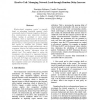Free Online Productivity Tools
i2Speak
i2Symbol
i2OCR
iTex2Img
iWeb2Print
iWeb2Shot
i2Type
iPdf2Split
iPdf2Merge
i2Bopomofo
i2Arabic
i2Style
i2Image
i2PDF
iLatex2Rtf
Sci2ools
ISCC
2007
IEEE
2007
IEEE
Head-to-Tail: Managing Network Load through Random Delay Increase
Window-based congestion control is typically based on exhausting bandwidth capacity, which occasionally leads to transient congestion. Moreover, flow synchronization may deteriorate conditions further, leading to persistent or more severe congestion, which is experienced by flows through increasing queuing delays and packet retransmission. Head-to-Tail is a new approach to queue scheduling that aspires to alleviate this problem. When conditions at the router’s buffer indicate high risk for congestion, Head-to-Tail delays packets intentionally to fabricate the senders’ impression about the network load. This implicit signal to reduce the transmission rate allows for a responsive behavior prior to congestion. In this paper, we evaluated Head to Tail with TCP Vegas and compared it with RED and other TCP variants. The initial results indicate that congestion events and retransmissions can be significantly eliminated.
Communications | Congestion Events | ISCC 2007 | Severe Congestion | Window-based Congestion Control |
| Added | 04 Jun 2010 |
| Updated | 04 Jun 2010 |
| Type | Conference |
| Year | 2007 |
| Where | ISCC |
| Authors | Stylianos Dimitriou, Vassilis Tsaoussidis |
Comments (0)

